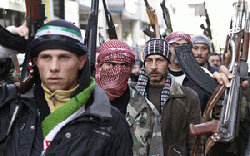BEIRUT – As Syria’s civil war grinds on, major differences are emerging between Islamist and secular rebel forces, raising fears that the defining conflict will be a showdown between these forces rather than battling the Damascus regime.
There are growing fears that the country will be divided in a war between north and south, a split that almost led to a civil war between the two regions in 1954 centered on Syria’s two great trading cities — Aleppo in the north and the capital Damascus in the south.
Analysts and other observers liken this to the intense rivalry in Libya between the Islamist east centered on Benghazi and the west dominated by Tripoli.
The friction between the rebels has deepened in recent weeks, with Islamist forces led by the increasingly powerful jihadist Jabhat al-Nusra and the Farouq Brigades of the Free Syrian Army at each other’s throats.
In January, Thaer al-Waqqas, leader of the FSA’s al-Farouq Brigade was killed in northern Syria amid suspicions he was involved in the death of Firas al-Absi, head of a group linked to the al-Nusra Front.
On March 24, Mohammed al-Daher, a popular al-Farouq commander in eastern Syria, was badly wounded in an apparent attempt to assassinate him by the al-Nusra Front.
The next day, Col. Riad al-Asaad, who established and initially commanded the FSA, was badly wounded in a car bombing. It was initially attributed to the regime but Syrian sources said it bore remarkable similarities to the attack on Daher.
“A full-blown civil war among the rebels is not out of the question,” said analyst Victor Kotsev.

U.S. history Professor Joshua Landis, who lived in Syria for several years and now teaches at the University of Oklahoma, says the real war in the country “is being fought on the ground by militia leaders who are becoming the real leaders of Syria.”
The Islamists, who fought mainly in the north and northwest around Aleppo where they were supplied from neighboring Turkey, are increasingly pushing south after taking the strategic Deir al-zur region and its oil fields.
In recent days they have taken regime bases near the Golan Heights, the strategic plateau in the south that has been largely occupied by Israel since 1967.
The Islamists’ presence has alarmed the Israelis, who fear they could come under attack on what for 40 years has been their quietest border.
Landis noted that the Islamists are heading south “down the Eastern highway toward Damascus …
“Already al-Nusra has a strong foothold in the Damascus region in the Palestinian neighborhood of Yarmouk, around the Jebel Druze and the Daraya-Adhamiya district of Damascus.
“Many Damascenes are fearful of being overrun by the North,” Landis observed. “The time-honored divide between North and South is again gaining relevance.”
He was referring to 1954, when the country split in half under the dictator Gen. Adib ash-Shishakli who had seized power in December 1949.
The north, led by mutinous Druze troops and Aleppo notables, rose against him and military forces began moving south on Damascus, where Shishakli ruled. Civil war was avoided at the last minute when the United States and Saudi Arabia convinced Shishakli to go into exile in the kingdom.
“Today,” Landis wrote in his blog, “Syria is not so lucky. North and South could be in for a real fight, dividing the country not only along geographic lines but also along ideological lines.”
Meantime, there’s strong speculation that the United States and Britain are seeking to build up the FSA and its allies around Damascus so they take the capital rather than have it fall into Islamist hands.
That would fit in with recent disclosures the Americans and British are working with the Jordanians, and to a lesser degree the Saudis, on training secular forces in the Hashemite kingdom on Syria’s southern border.
But, Landis observed, “it is not clear how committed the U.S. and the West are to manning up the opposition in the South of Syria to get the jump on the growing Islamic tide washing down from the North.”
Kotsev said, “The noose around Damascus is slowly tightening and many observers believe the fall of the capital is a matter of time.”
Meantime, he added, “it remains to be seen who disintegrates first: the regime or the main rebel groups opposing it.”
-UPI






Leave a Reply